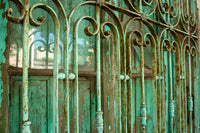Clients reach out to us all the time asking if their old wrought iron pieces can be saved. Whether it’s a railing, gate, or custom feature, they want to know what’s worth keeping and what’s not. One way to tell if it's worth salvaging is to learn to identify surface rust vs rot.
This article is here to help you figure that out. Salvaging wrought iron isn’t just practical, it’s often the smarter, more sustainable choice. You get to keep the character of the original piece, save money, and avoid waste. If you’ve ever wondered whether something is worth salvaging, this guide is for you.
Identifying Surface Rust VS Rot
Surface rust usually appears as a thin, flaky, orange-brown layer on top of the metal. It can be brushed or sanded off without weakening the piece. Rot, on the other hand, shows up as deep pitting, scaling, or holes that compromise the iron’s strength. If pressing on the metal causes crumbling or it feels soft in places, you’re likely dealing with rot rather than just surface rust.
1. Check for Structural Integrity
If the piece still feels solid when you lift or press on it, no wobbles, deep cracks, or breaks, it’s a good sign. Surface rust might look bad, but it doesn’t mean the piece is done for. What matters is the core strength.
2. Look at the Connection Points
Joints, welds, and attachment spots are key. If these areas are holding up, even with some wear, you’re in a great position to restore. If they’re completely rusted through or falling apart, it may be more trouble than it’s worth.
3. Assess the Level of Rust or Rot
Surface rust is normal and usually easy to clean up. Deep pitting or flaking, especially in load-bearing areas, means you’ll need to do more work, but that doesn’t always mean the piece is a lost cause. We’ve brought worse back to life.
4. Consider the Design and Craftsmanship
If it’s a custom piece with detailed scrolls, rivets, or old-world joinery, it’s probably worth saving. These kinds of details are hard (and expensive) to replicate today, so restoring them is almost always the better option.
5. Estimate the Work Involved
Some projects need a quick clean and repaint; others need welding, filling, and full refinishing. Ask yourself, or ask us, how much effort and cost is reasonable for what you’ll end up with. Sometimes, it’s well worth the time.
6. Think About Its Location and Purpose
If it’s decorative, you have more flexibility with imperfections. But if it’s a handrail or gate, it has to meet certain strength and safety standards. Keep that in mind when deciding whether to restore or replace.
Salvaging Process
Safe Removal Techniques
Start by carefully separating the piece from its base, whether it’s set in concrete, attached to wood, or bolted to metal. The key here is to avoid adding more damage to something you're trying to save. Use tools like a reciprocating saw or angle grinder with a light hand, and always wear safety gear. Take your time around joints and fasteners; they’re often the most fragile parts.
Cleaning and Preparation
Once it’s removed, the real work begins. Cleaning is where you see what you're actually working with. Remove dirt, grease, old paint, and surface rust using a wire brush, sandpaper, or a power tool if the piece can handle it. This step gives you a clear view of any deeper damage and gets the iron ready for restoration or refinishing.
Addressing Rust and Rot
Some rust is fine, expected even, but if it’s deep or spreading, it needs to be handled before any refinishing happens. We recommend using rust converters for minor cases or structural fillers for pits and missing chunks. Always follow up with a protective primer to seal it and prevent future damage.
If you want a deeper dive into these steps or need help with specific techniques, head to the blog section of our website. We’ve covered everything from cleaning and cutting wrought iron to full restoration guides, perfect if you're planning to take on more than just salvaging.
Creative Repurposing Ideas
Turn Old Railings into Garden Trellises
Wrought iron railings make beautiful, sturdy trellises for climbing plants. You can anchor them against a wall or let them stand alone in a garden bed. They add both function and character, plus, they hold up well in all weather.
Make a Statement Piece for Your Entryway
An ornate gate or railing section can be mounted as wall art or turned into a custom coat rack with a few added hooks. It’s a great way to bring old-world charm indoors while giving new purpose to something that would’ve gone to waste.
Create a Custom Furniture Piece
Salvaged iron scrollwork or panels can be incorporated into furniture like the base of a coffee table, a headboard, or a bench backrest. Add some wood or glass, and you’ve got a one-of-a-kind piece that’s both functional and full of history.
Conclusion
We hope this article helped clear things up and gave you the confidence to look at your old wrought iron pieces in a new light. Salvaging isn’t just possible, it’s often the smartest, most rewarding option. Now that you know what to look for and how to approach it, you can finally move past the “should I keep this?” stage and start doing something about it. And if you ever need a hand or a second opinion, you know where to find us.
Need expert help or custom pieces? Contact us or explore our wrought iron collection.









